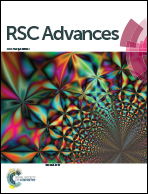Two chiral alkanolamine Schiff base Cu(ii) complexes as potential anticancer agents: synthesis, structure, DNA/protein interactions, and cytotoxic activity†
Abstract
Two Schiff base copper(II) complexes, [Cu(R-L) (CH3OH)]8 (1) and [Cu(S-L) (CH3OH)]4 (2) {[R/S-H2L = R/S-3-phenyl-2-(2-hydroxy-5-chlorobenzylideneamino)propane-1-ol]}, have been successfully achieved and fully characterized by single-crystal X-ray diffraction (SXRD), mass spectrometry (MS), Fourier transform infrared spectroscopy (FT-IR), and elemental analysis (EA). The interactions of complexes 1 and 2 with calf thymus DNA (CT-DNA) and bovine serum albumin (BSA) have been comprehensively investigated using various electronic absorption spectroscopies. The thermal denaturation, viscosity, and UV-Vis spectra data suggested non-intercalative binding between DNA and the complexes. Additionally, an in vitro cytotoxicity test on the two complexes towards four types of human cancerous cell lines (HL-60, Caco-2, A549, and HeLa) indicated that the two complexes exhibited substantial cytotoxic activity. Especially, complex 2 exhibited excellent data, with IC50 = 10.97 ± 1.22 against HL-60 cells, which indicated that the two chiral complexes play significant roles in the cytotoxicity and interactions with DNA and BSA.


 Please wait while we load your content...
Please wait while we load your content...